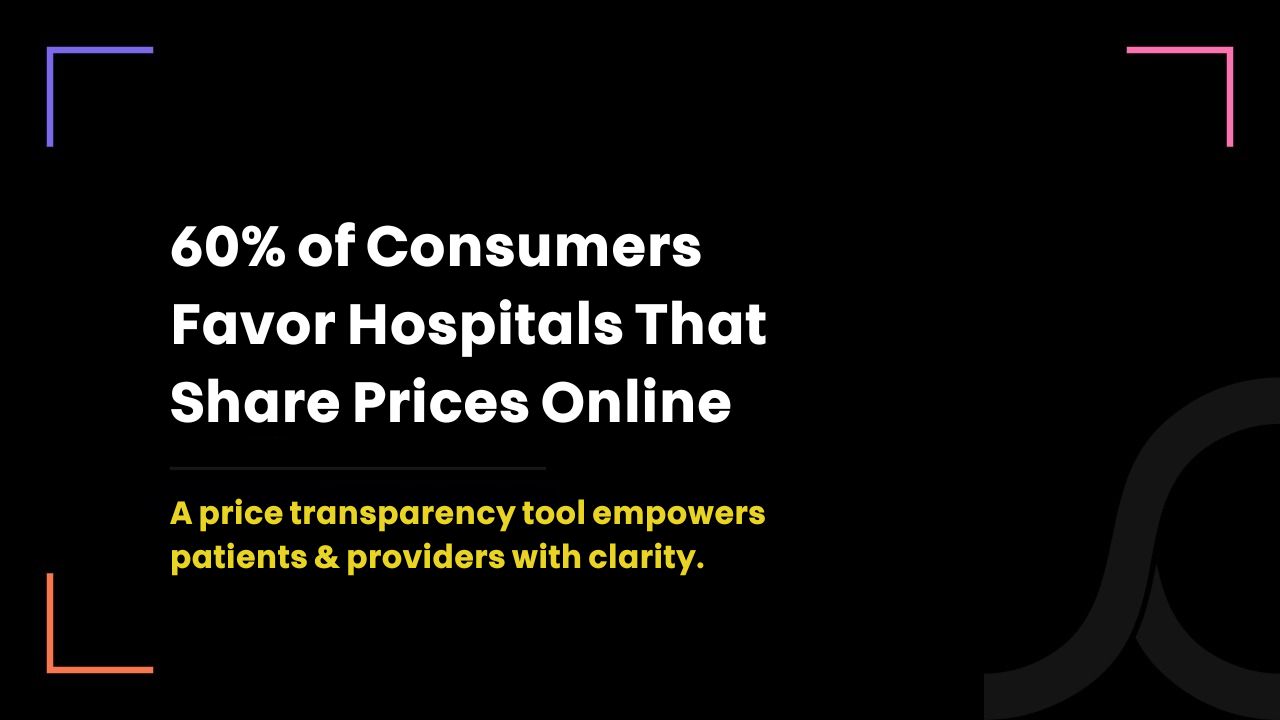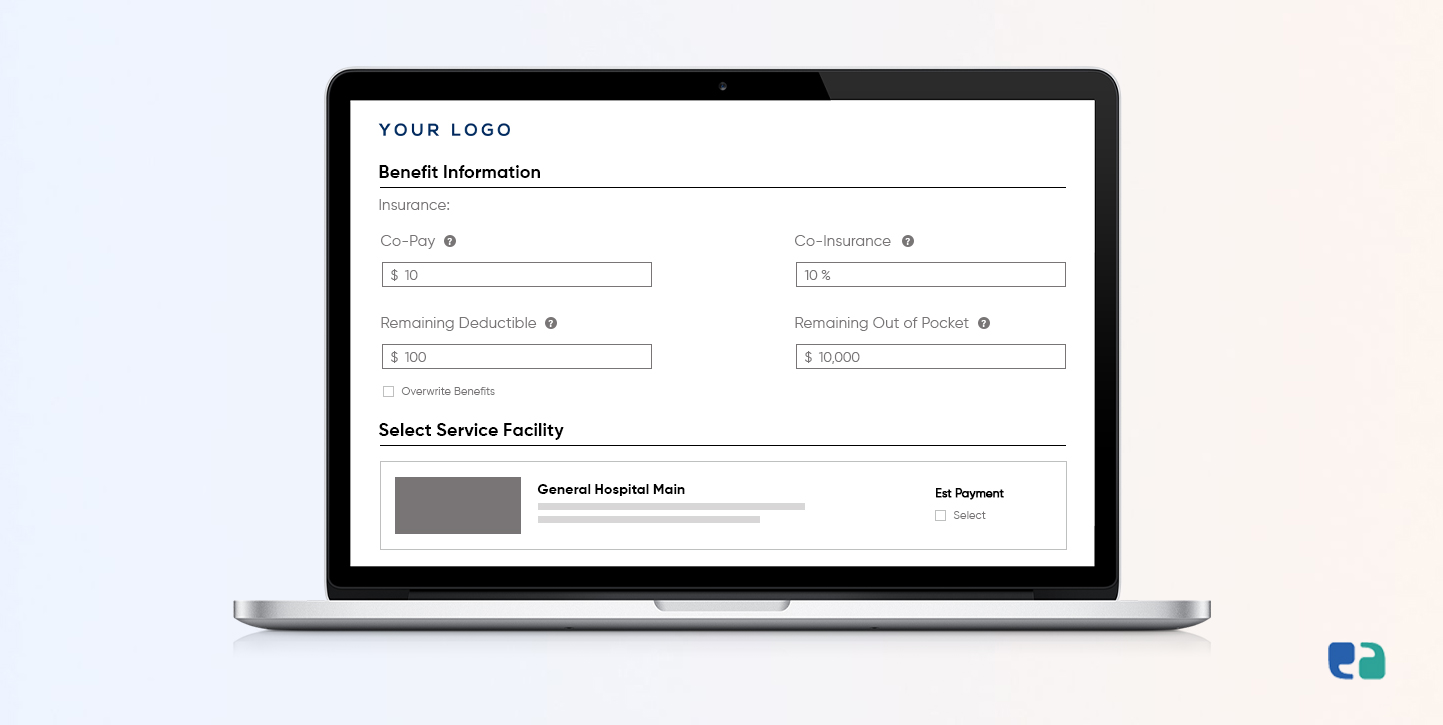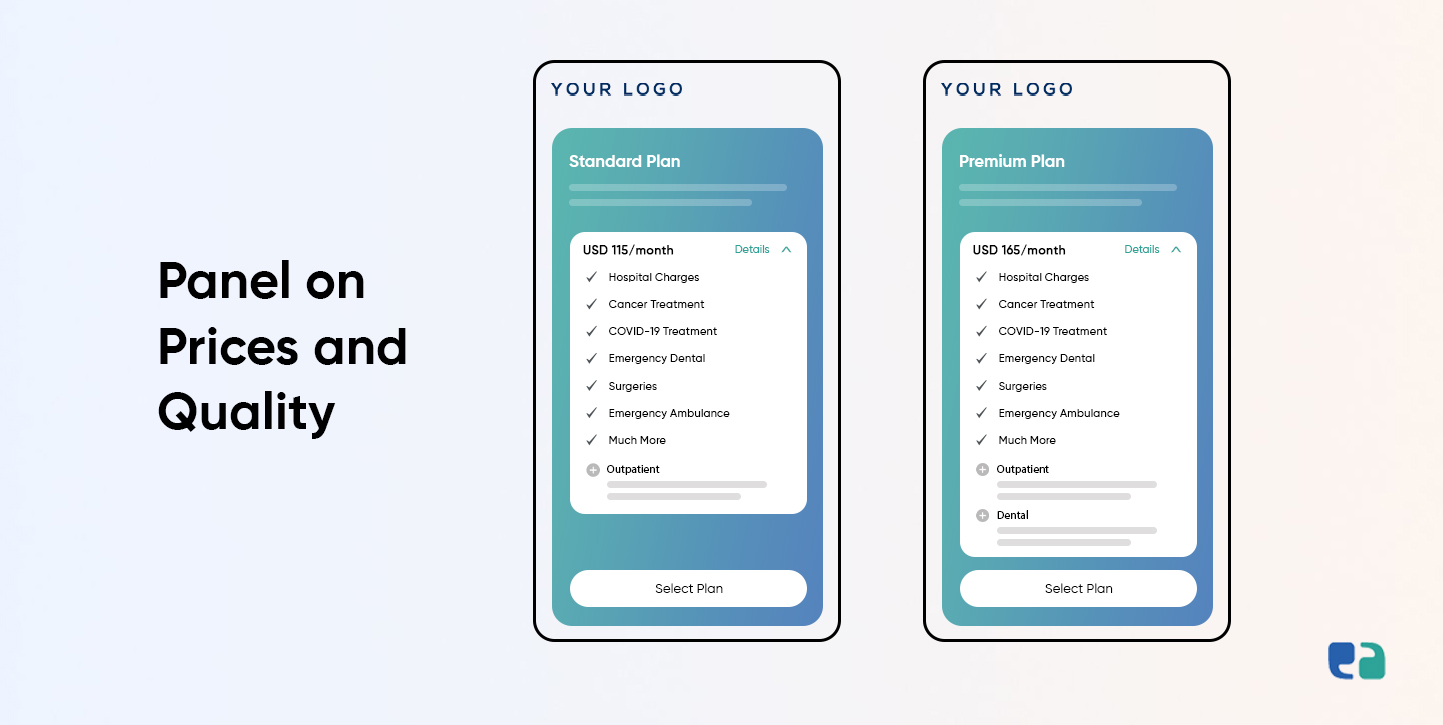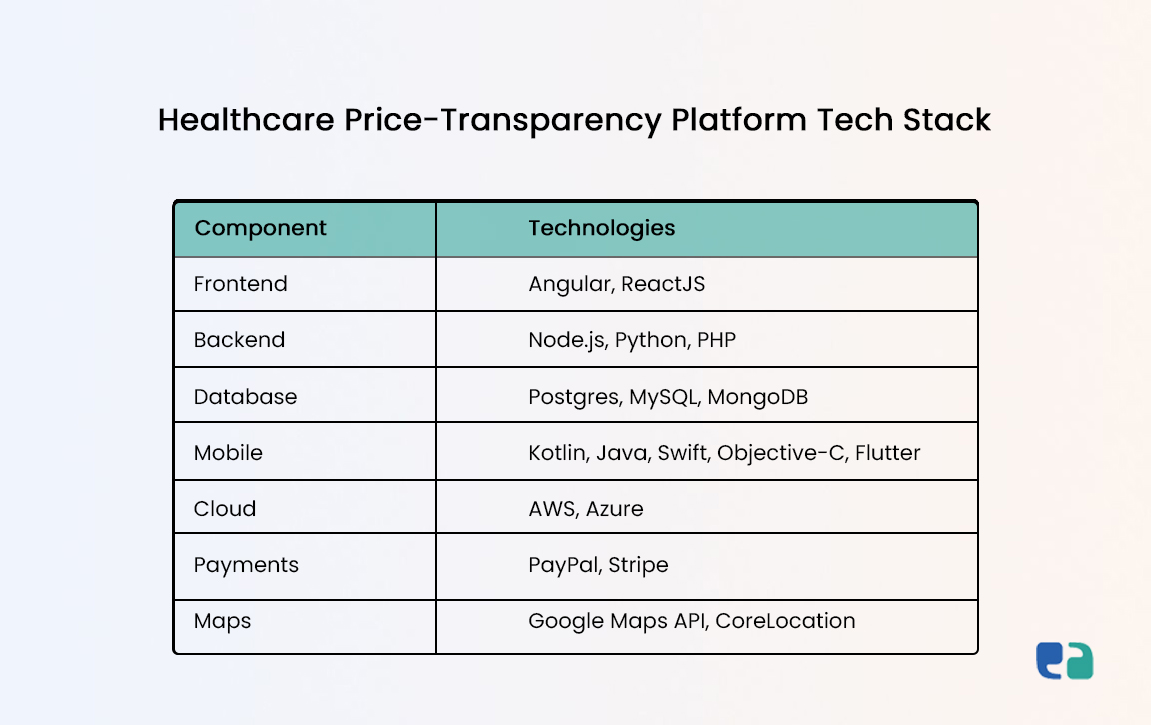Healthcare Price Transparency Software Development: Features, Cost & Examples

10 months ago
Let's spill the truth.
It doesn't matter what an average Canadian or American earns; one hospital visit and all your money disappears.
And you know what makes it expensive: the complexity of healthcare billing.
Maybe you're paying for services that you didn't even need or receive.
And it's creating a feeling of being cheated among patients. The statistics also support this.
As 53% of healthcare consumers are now using cost estimation apps, it clearly shows that patients want more transparency.
So if you want to make a change and also generate revenue from this problem, building price transparency software is not a bad idea.
Let's see how we can help you convert this crisis into a profitable business opportunity.
Problems Created Due to a Lack of Price Transparency Solution
1. Unexpected Medical Bills
In the USA, one of the main reasons behind bankruptcy is the lengthy healthcare bills.
This is due to sudden billing surprises that lead to mismanagement of hospital billing budgets.
2. Low Awareness of Pricing Tools
There is a legal rule requiring health insurance companies to include Transparency in Coverage so that they can provide pricing data.
However, most American patients don't know that these rules exist, or they are unaware of the tools that can provide this information.
The lack of accessible information leads them to pay more than they should.
3. Difficulty Comparing Costs
Comparing healthcare costs is not easy.
Every provider and hospital gives a different estimate for their services, which puts patients in a situation of unclear decision-making.
4. Challenges for Employers
Employers are your biggest target audience if you're trying to build such a tool.
They are responsible for paying the healthcare costs of their employees, but this unclear expense becomes an extra burden on their shoulders.
This makes it harder for these employers to manage and predict their healthcare spending.
How Price Transparency Software Helps Patients & Stakeholders
The core issue behind all these challenges is inaccessible information and complex billing data.
A price transparency tool can address these challenges like a smart assistant.
Let's explore some of the benefits of this solution.
1. Informed Decision-Making
Now patients can get clear and accurate pricing details. It allows them to make informed decisions based on both cost and quality of care.
2. Better Cost Control
If patients know the cost, they can manage it better.
It saves them from surprise charges on additional services and gives them more control over their financial planning.
3. Improved Healthcare Outcomes
If patients had accurate information about their healthcare billing, they could save money on additional services and invest more in quality care.
This would lead to better healthcare outcomes and give them the option to select high-quality care.
Serif Health: An Example of Innovation in Price Transparency

Founded: 2020
Location: Los Angeles, CA
It's always good to learn from companies that are already making it big in your interest area.
Therefore, we have brought a revolutionary example, Serif Health.
Their big data-driven solution collects data from different health plans.
This data comes from machine-readable files required by the Transparency in Coverage Rule.
They provide a simple search portal to patients where they can access all their information with ease.
You want to know how big technology helps in this? Let's listen to the words of Matthew Robben, the CTO of Serif Health:
"One set of files can be 285 GB! That’s about 66 billion records.
This huge amount of data comes from 30,000 to 50,000 billing codes linked to 2 million providers across 337,000 facilities in the U.S.
To handle all this data, we use advanced technology like ClickHouse."
This lets users search for specific procedures, providers, and locations easily. They provide their services to employers, providers, and other healthcare companies.
See the screenshot of the Serif Health Portal and get an idea about your portal—how plans and providers are compared.

Positive Impacts of a Medical Cost Estimator Tool
Price transparency software has many benefits for everyone in the healthcare system. Let’s take a look at how it helps different groups.
1. Benefits for Patients
- Better decision-making
- Selection of quality care
- Avoid sudden billing shocks
- Compare treatment prices
- Build trust
2. Benefits for Providers
- Helps healthcare providers stay competitive
- Allows adjustment of pricing strategies
- Enables better contract negotiations with payers
- Strengthens relationships with patients through transparency
3. Benefits for Employers
- Control medical expenses
- Creation of better health plans
- Better negotiations with providers
4. Benefits for Health Plans
- Manage your network optimally
- Help in finding high-value providers
- Data insights to improve plans
Challenges in Building Healthcare Cost Transparency Platform
Building every solution comes with certain challenges, and cost transparency solutions are no exception.
Worry not—our health tech team has created some solutions. Let’s look at some important ones.
1. Data Acquisition and Processing
It's a tough task to extract and clean large amounts of data.
As we know, it is important that the data is machine-readable—regulations require it that way. But the data is mostly messy and inconsistent.
So, there is a need for data processing to make it useful.
2. Technical Infrastructure
Without technical infrastructure, building such a solution is not possible.
It requires technical robustness to manage large databases and provide real-time information.
You would need a powerful database that can handle billions of records efficiently.
3. User Experience
Data is complex, and managing it is even more challenging.
But users don’t have to deal with this.
They always prefer data that is easy to access and understand.
Make sure your solution simplifies it before providing information.
4. Regulatory Compliance
Always follow the rules of the land in healthcare tools.
Whatever country you're making a solution for, make sure your healthcare solution complies with their local regulations, like PIPEDA or HIPAA.
Features You Must Include to Build an Effective Healthcare Price Transparency Platform

1. Comprehensive Data Coverage
Your platform should have data from all the health plans and any medical services that are covered.
With more information, you can help the patient more.
2. Real-Time Data Updates
Being up to date is key to success for any platform. It’s meaningless if you're providing old information; you might lose trust.
So, make a solution that remains in sync with healthcare pricing changes (as they change frequently).
3. User-Friendly Search and Filtering
Intuitive search and filtering tools are a must. Patients should easily find what information they need.
Provide procedures, providers, locations, or health plan information in the blink of an eye.
4. Personalized Cost Estimates
- Offer personalized cost estimates based on individual health plans
- Help users understand their out-of-pocket expenses better
5. Data Visualization and Analytics
A picture is worth a thousand words, and this is clearly true here as well. Charts and graphs help provide a complete overview. For senior patients, it's even more important.
6. API Integration
- Allows your platform to connect with other healthcare applications
- Streamlines workflows and enhances functionality

Essential Technical Elements for Your Healthcare Cost Transparency Platform
1. Data Storage and Management
Choosing the right database technology is very important. You need a system that can handle large volumes of data efficiently.
2. Data Processing and ETL Pipelines
You’ll need efficient ETL pipelines to process raw data. It cleans and standardizes the data so that the system can utilize it optimally.
3. API Development and Integration
You need to collaborate with tech experts who can build secure APIs for your system. They will also help in integrating these APIs with other systems.
4. Frontend Development
A clean, easy-to-access user interface is very important. A well-designed frontend makes it easier for patients to adopt your solution.

Importance of Scalability and Security
Scalability
- Handle increasing data & user traffic as your solution grows
- Ensure scalable architecture to keep the platform responsive.
Security
Protecting sensitive patient information is a top priority.
- Platform complies with PIPEDA/HIPAA
- Use ethical and unbiased data
- Implement strong security measures like authentication and encryption
Developing a Healthcare Price-Transparency Platform: A 6 Step Guide
Creating a price-transparency platform is a journey that involves several important steps. Let's break it down:
1. Data Acquisition and Aggregation
- Find Your Data Sources: You can start by identifying where to find relevant pricing data. Most of this health information is in machine-readable files from health plans, as required by the Transparency in Coverage Rule. You can get these files from health plan websites.
- Build Data Pipelines: Since there’s a lot of data, you have to create automated pipelines to collect it efficiently.
2. Data Processing and Transformation
- Clean and Standardize Data: The data you collect is quite messy and inconsistent. You need to clean it, meaning fixing errors. This will bring consistency and standardization.
- Enhance Your Data: You can provide better insights if you add extra information to it. This information may include details about procedures, providers, or quality metrics.
3. Database Design and Implementation
- Choose the Right Database: You need a database that can handle huge amounts of data, like billions of records at one point in time.
- Create a Data Model: Organize your data effectively so it’s easy to store and retrieve.
4. API Development and Integration
- Build Secure APIs: Develop robust APIs that allow secure access to your required information. These are very important for your platform and any third-party apps.
- Implement Security Measures: Follow PIPEDA compliances and protect sensitive data by setting up strong authentication and authorization for API access.
5. Front-End Development
- Design an easy-to-use interface to help users search and understand pricing information
- Add search and filtering tools to make it simple for patients to find desired information
- Include charts and graphs to highlight pricing trends and aid decision-making
6. Platform Testing and Deployment
Check everything works as it should. This includes unit tests and user acceptance tests.
Launch your platform on a secure and scalable infrastructure. You can consider using cloud hosting for flexibility and resilience.

